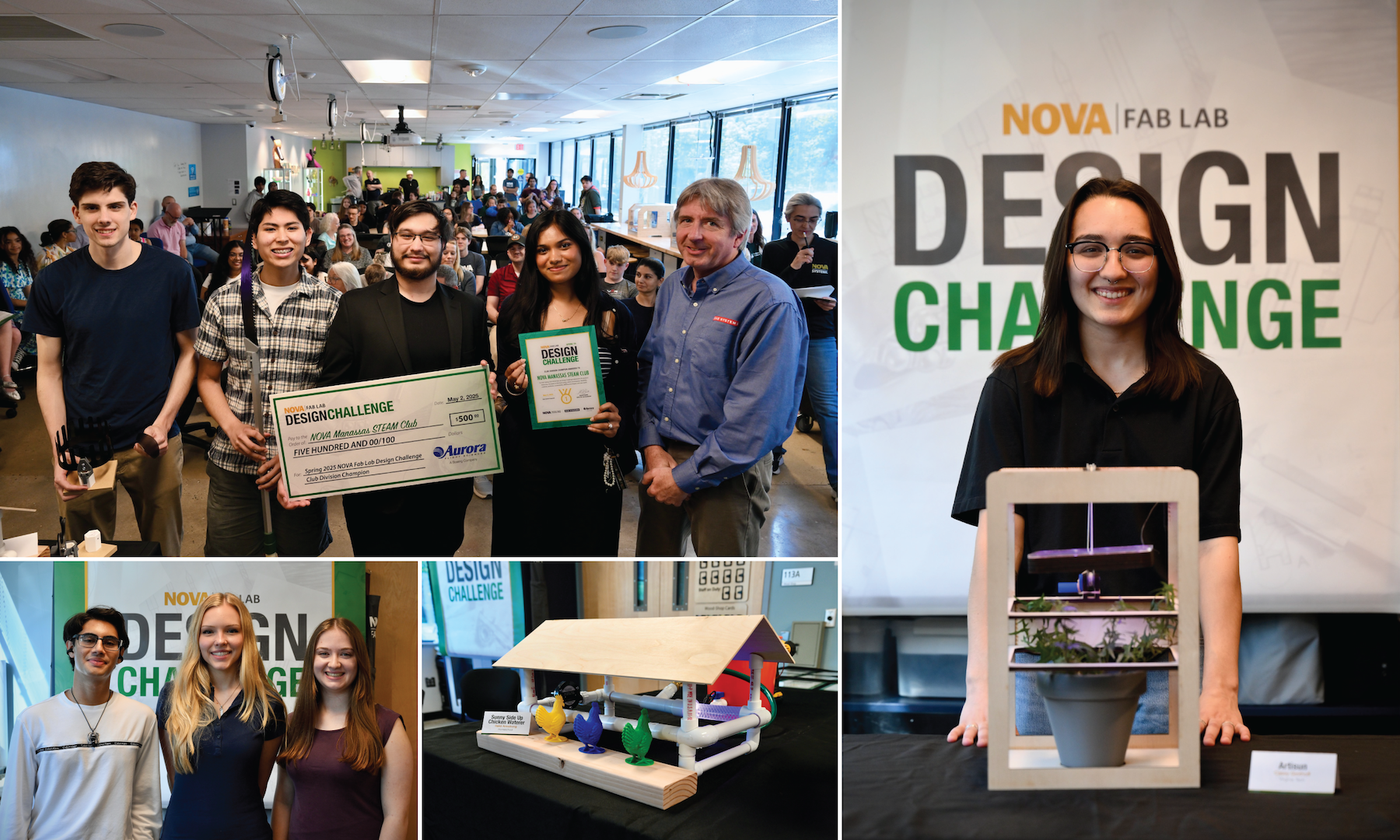
On Friday, May 2, the Fab Lab hosted its fifth annual Spring Design Challenge Award Ceremony. This year’s challenge invited students to design a physical product that improves any aspect of growing, accessing, cooking, serving, or packaging food. Open to students age 10 and up, the competition introduced a new Student Club division, allowing school-affiliated clubs from middle school to post-secondary to participate—thanks to additional support from Aurora Flight Services. Funded entirely by BAE Systems, the challenge entries were judged on creativity, aesthetics, feasibility, and effectiveness.
Judges included David Tuohey, a senior process engineer at BAE Systems in Manassas; Lauren Traversa, a NOVA graduate and mechanical engineering student at Virginia Tech; Carey Tang, restaurant owner and managing director of Rooster & Owl; and Philip Peppler, food safety coordinator at Wegmans.
Elena Ziu, a NOVA physics professor, and her son, Mihai, coordinated this year’s challenge, facilitated the judging process, and—along with NOVA IET graphic designer Valerie Bierhuizen—fabricated the winning designs.
Heidi Armstrong, a homeschool student, earned first place in the 10–15 age category with her design, Sunny Side Up Chicken Waterer. Heidi’s family raises chickens and had trouble providing water efficiently. Nipple waterers were their main source, but they don’t help chickens cool off. Cup waterers fix that issue but are hard to clean and break easily. Heidi aimed to solve both problems—and create a large water reservoir that would allow her family to leave for longer periods without worrying about sustainability. Her design collects rainwater into a large reservoir, which feeds into a solar-powered chicken watering station equipped with a UV-C light and water pump.
“I didn’t even know this was a problem, and it’s such a kind, elegant solution,” said David Tuohey. “It clearly took a lot of preparation, and with the submission in hand, you could probably just go to the hardware store and pick up all the pieces.”
Ethan Meyer, a student at Colgan High School, took second place with EggHead, which uses a trampoline-style shock-absorbing system to reduce the sudden movements that cause eggs to break during transportation.
Millie Stanzel, a student at The Potomac School, received an honorable mention for her Spoon-Sifter—a hybrid kitchen tool that combines a spatula, a one-cup measuring spoon, and a flip-up sifter.
Heidi received $500, Ethan received $250, and Millie received $100.
Virginia Tech student Casey Grothoff earned first place in the 16+ age category for her Artisun automated plant care system.
“I grow indoor plants and noticed most automated systems overlook light variations,” Casey said. “My idea uses red and blue light based on a plant’s life cycle—blue for growth, red for blooming—making the process more energy-efficient than using just white light. A camera monitors the plant’s stage and adjusts the light accordingly.”
The system also integrates watering and other functions for full automation, but the innovation lies in its adaptive, energy-efficient lighting.
“This has real-world potential—I can easily see it being advertised and sold,” said judge Carey Tang. “It was a very thoughtful design.”
Hasan Khan, a student at the Governor’s School @ Innovation Park and Osbourn Park High School, took second place with Sunflower Tower, a vertical farming system that features a floral-shaped solar panel, modular hydroponics, and a built-in fish tank to create an environmentally sustainable cycle for space-efficient farming.
NOVA student Erika Crane received an honorable mention for her Hot and Crispy Food Packaging, a cylindrical takeout container with flaps that retain heat while allowing steam to escape—keeping food warm and fresh.
The NOVA Manassas STEAM Club took first place in the Student Club division for their Branch Out Modular Harvester.
“I approached this with a business mindset: the product must work well and attract as many clients as possible. While it’s great for gardening, it has other uses too. It’s not a primary tool—it’s meant as an emergency substitute,” said club member Dylan.
“I really like the design’s efficiency, compactness, and versatility. Instead of carrying four or five tools, you only need one,” added judge Philip Peppler.
The Spring Design Challenge highlighted the creativity, collaboration, and real-world problem-solving skills of students across all age groups. With support from industry professionals and educators, the Fab Lab continues to inspire the next generation of innovators.